A FULLY ADJUSTABLE BUBBLE HORIZON – NEWLY REBUILT
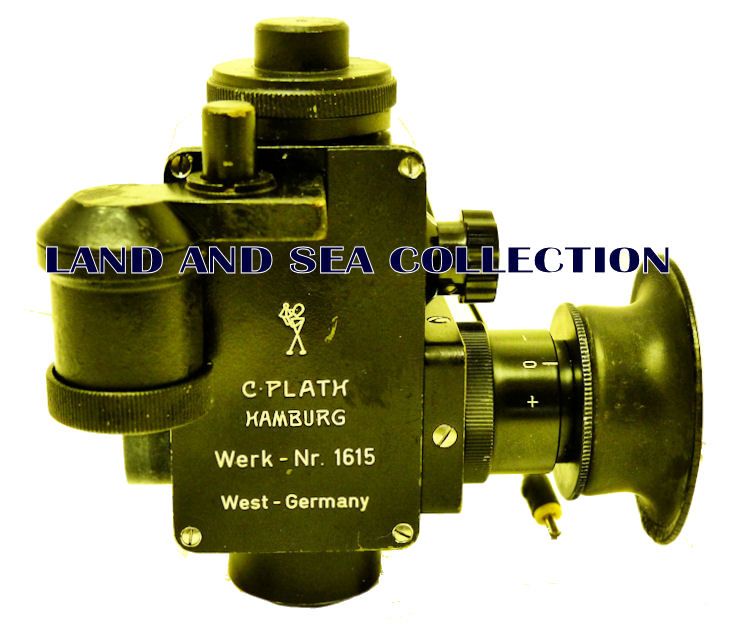
This is one of the very rare C. Plath Bubble Horizons that has a fully adjustable bubble, and a rheostat for adjusting the brightness of the internal lighting system. Regardless of what you read elsewhere on the internet, the trade name of this unit was “DRAGONFLY” , and the design dates back to WW II, when these devices were successfully used on all types of surface ships and submarines. After cessation of hostilities, Plath did not get back into the sextant business until about 1954, and this version was reintroduced to the Commercial Marine Market in 1957. During the period 1950-1960, the German Navy requested this design be used in the “Libellenhorizont” and from 1970 through 1980, similar devices were issued to U.S. Submarines to allow for backup celestial navigation under all conditions. They also were much in demand by the world’s merchant mariners.Because of the expensive design, not many of the Dragonfly bubbles were made after WW II, before they were discontinued and replaced by a more simplified version that eliminated the adjustable bubble, and finally the adjustable lighting was discontinued. Plath received many comments from users of these devices who preferred the fully adjustable versions and felt the new one was a step backwards. Over the years, the new version Plath bubbles have been well accepted by seagoing users, and the demand for them continues even as they become more difficult to find.
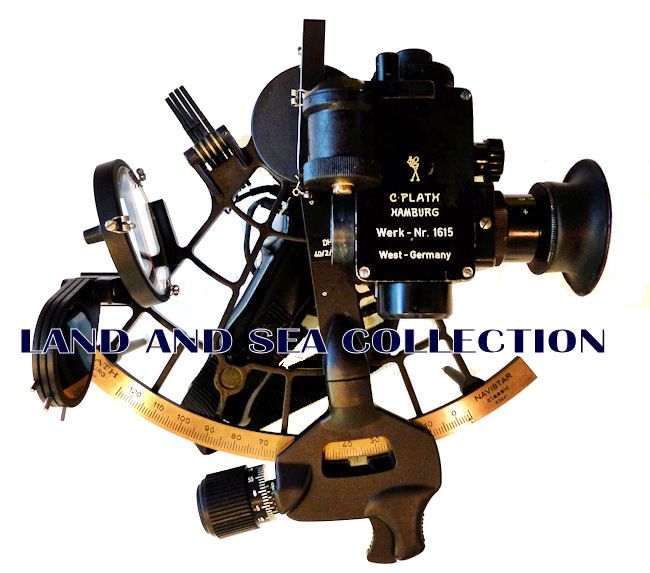 |
| Mounted on 1983 – 84 C. Plath Navistar Classic |
| THE SEXTANT PICTURED IS NOT INCLUDED in this offering, but is available for sale.
It is a like new 1984 C . Plath Navistar Classic with history. |
The adjustable bubble for sale underwent a rigorous rebuild by an expert in these rare devices that included:
- Complete disassembly of the instrument (except the bubble chamber subassembly)
- Clean and polish all screws.
- Clean all other parts except the bubble sub-assembly which is in good workable condition. It was partially cleaned.
- Remove dimmer, disassemble, clean and reassemble
- Solder new cables to dimmer, replace dimmer adjustment knob with new
- Clean optical system
- Adjust mirrors to correct position
- Reassemble complete instrument and field test
The disassembly of this instrument indicates it is of an early design from WW II despite the higher serial number.
CONDITION: Used. Rebuilt as above. The bubble chamber was not leaking and had no evidence of deteriorartion and was left “as is” except for cleaning of the visable exterior. On the exterior of the unit, it was decided that the instrument should not be repainted. Consequently, it shows the marks of age, wear and previous touchup. The dimmer adjustment knob is new. The slip-on green filter for the objective lens is missing. A power extension cord is included with a spare bulb.
In the photograph below, it is shown alongside the last bubble horizon design made by C. Plath which has an internal power supply. Like all Plath bubbles, except for the one being offered, the size of the bubble is not adjustable. On July 3, 2008, Ken Gebhart of Celestaire wrote us that the last version was discontinued around 2001, and sold new for $1,700.00.
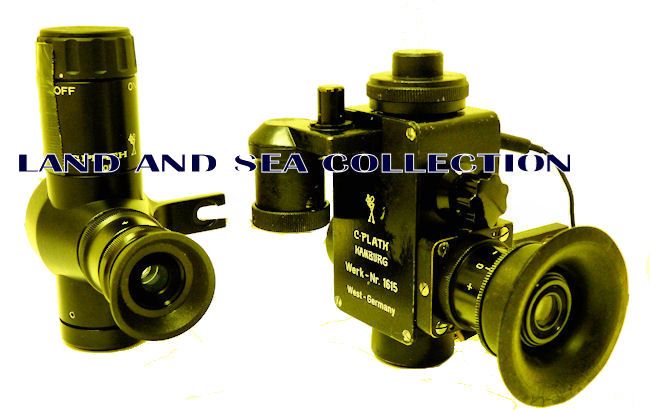 |
| Ca 2000 C. Plath Bubble vis-a-vis this Ca 1957 fully adjustable version |
DIRECTIONS & INSTRUCTION SHEETS: A Plath sheet of instructions in German and English comes with the device. There also will be a diagram of the internals and a diagram of the geometry of the optical system. The device is simple to use and provides an artificial horizon using a circular illuminated bubble as a substitute for a horizon reference. The bubble is centered at the midpoint of the viewing area and the celestial body is brought into coincidence with the bubble’s center. Intensity of the internal light is adjusted by a small knob on the front. Bubble size is adjusted, by the larger rotary dial on the base of the cylinder on the left. A large bubble is preferred for sun and moon sights, and a smaller bubble for stars and planets. The ocular lens is adjustable. Land An Sea Collection’s Supplemental Instructions are also included.
 OUR QUALIFICATIONS: We are one of the few company’s still selling navigation instruments that know anything about them. For purposes of judging whether Joel’s opinion counts, he was the editor of the chapter on sextants of the 1977 Edition of “Bowditch”, The American Practical Navigator, NAVPUB 9; a member of the U.S. Naval Academy Navigation Symposium, 1975 -1978; the author of a book on marine sextants, Cornell Maritime Press,1975, and the founding president of Nautech Maritime Corporation which partnered with Tamaya of Japan in the introduction of the MS 733 Spica, the MS 833, Jupiter, MS 933 Venus sextants and the famous NC-2 navigation computer, in the U.S. market. Joel is a retired Master Upon Oceans, and held a U.S. Navy “D” Qualification as a Senior Skipper – Oceans. For six years he was a Varsity Offshore Sailing Team Coach at the U.S. Naval Academy. Some of his memberships have included the: Association of Naval Aviation, Silver Wings, The Tailhook Association, Naval Academy Sailing Squadron, McCampbell’s Aces Squadron, Naval Historical Foundation, and the Naval Order of the United States.
OUR QUALIFICATIONS: We are one of the few company’s still selling navigation instruments that know anything about them. For purposes of judging whether Joel’s opinion counts, he was the editor of the chapter on sextants of the 1977 Edition of “Bowditch”, The American Practical Navigator, NAVPUB 9; a member of the U.S. Naval Academy Navigation Symposium, 1975 -1978; the author of a book on marine sextants, Cornell Maritime Press,1975, and the founding president of Nautech Maritime Corporation which partnered with Tamaya of Japan in the introduction of the MS 733 Spica, the MS 833, Jupiter, MS 933 Venus sextants and the famous NC-2 navigation computer, in the U.S. market. Joel is a retired Master Upon Oceans, and held a U.S. Navy “D” Qualification as a Senior Skipper – Oceans. For six years he was a Varsity Offshore Sailing Team Coach at the U.S. Naval Academy. Some of his memberships have included the: Association of Naval Aviation, Silver Wings, The Tailhook Association, Naval Academy Sailing Squadron, McCampbell’s Aces Squadron, Naval Historical Foundation, and the Naval Order of the United States.
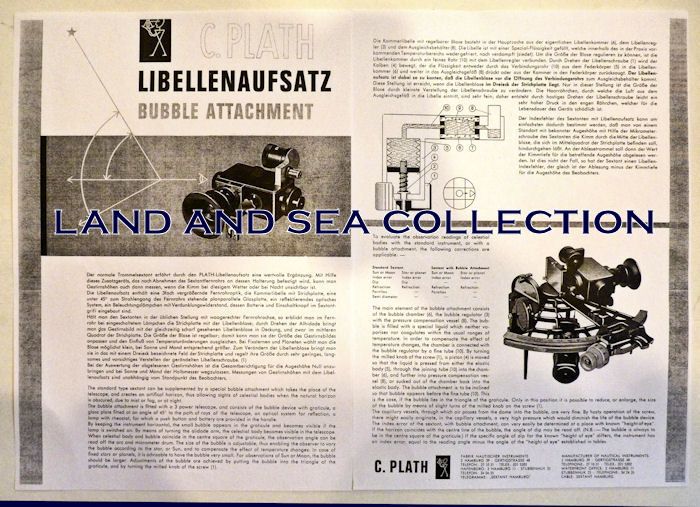 |
| Two pages instructions in German and English |
Werk-Nr. 1613, over West Germany.
C. Plath Navistar Classic sextant. With an external battery supply, it will work with Ca 1990 C. Plath sextants, Cassens &
Plath, Tamaya, Freiberger, and the Russian CHOT/SNOT.
 |
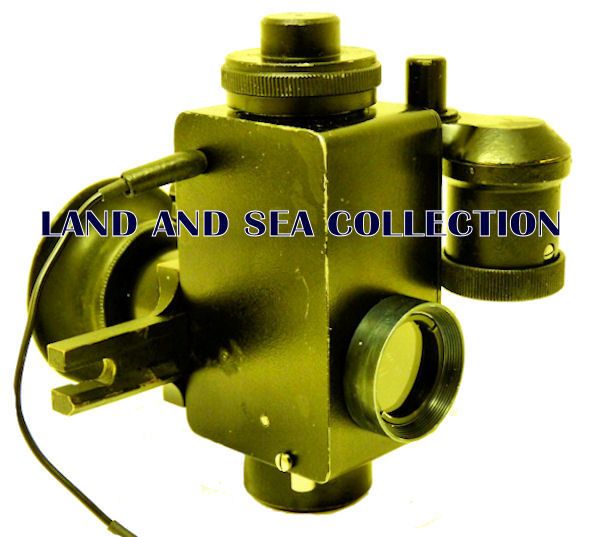 |
| Rheostat center, bubble adjustment to left | Top cap holds bulb |
SUGGESTED USE: The bubble horizon has a 3 power optical system and a smaller than normal field of view. The internal dampening mechanism of the bubble is greater than will be found on less costly alternatives, but requires some practice in getting used to. The Plath, fully adjustable Bubble Horizon is far superior to all other artificial horizons, and the devices that can only be used for objects with altitudes of less than 60 degrees, and cannot be used for twilight sights. This makes it ideally suited for land based training applications, for land navigation and for use at sea from ships large enough to be a stable platform.
C. PLATH BUBBLE HORIZON SPECIFICATIONS:Magnification 3 X 4″ 1/4 H x 4 1/2″ L x 3″ W not counting rising pieceSlip-on green filter not fitted to this unit by the factoryWeight: 1 lbs 1 3/4 oz
COMPANY HISTORY: In brief, Carl Plath started manufacturing sextants, in addition to other nautical
products, in Hamburg Germany in 1862 though the purchase of the David Filby instrument company though the company’s origin dates back to 1837. As a result WW II, C.Plath was dismantled completely by the occupation forces. Around 1950, various prohibitions were lifted, and C. Plath was allowed to begin production again of sextants and other nautical instruments. Also in 1949,C.Plath was offered a gyrocompass patent and in 1951 the first gyrocompass designed to this patent was presented to the public. C.Plath progressed from the role of instrument maker to that of a modern marine navigation equipment manufacturer. In the following years the product range was expanded by many more modern designs such as autopilots, speed logs, radio direction finders, etc.In 1962 C.Plath was acquired by Litton Industries, a large American concern.The C.Plath North American Division was set up in 1978 in College Park near Washington. 1996 saw the introduction of the world’s first fiber-optic solid-state gyrocompass by C.Plath. The first ever gyrocompass with no moving parts. Sperry Marine was formed in 1997 with the combination of C.Plath, Decca Marine and Sperry Marine with more organizational changes yet to come. After 163 years, C.Plath changes its name to Sperry Marine in May 2000. In 2001 Sperry Marine becomes part of the Northrop Grumman Corporation. In the 1990’s Plath came out with a series of new sextant designs with overlapping designs and confusing names. Shortly thereafter, C. Plath quit producing sextants. The parent
company has completely liquidated everything including machinery, equipment and spare parts.
